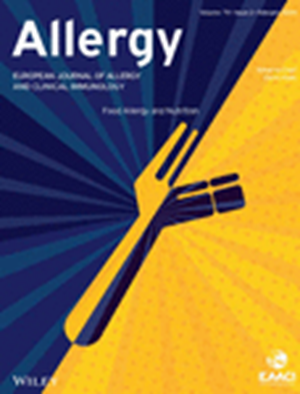屋尘螨免疫治疗中国不同致敏模式变应性鼻炎患者的疗效:一项多中心研究(COVER研究)。
IF 12
1区 医学
Q1 ALLERGY
引用次数: 0
摘要
背景:过敏原免疫治疗(AIT)是变应性鼻炎(AR)患者唯一的病因治疗方法,但过敏原致敏模式对AIT疗效的影响尚不清楚。本研究旨在评估使用天然屋尘螨(HDM)过敏原提取物进行皮下免疫治疗(SCIT)对具有不同HDM致敏模式的中国AR患者的有效性。方法本前瞻性多中心研究纳入了中国3个过敏反应中心5-65岁诊断为HDM诱导AR的患者,对9种HDM成分(Der p1, Der p2, Der p23, Der f1, Der f2, Der p5, Der p7, Der p10, Der p21)进行血清特异性IgE检测,将患者分为两组:A组对主要过敏原成分致敏,B组对次要过敏原成分致敏,或不含主要过敏原成分。两组均接受为期1年的HDM SCIT (Allergopharma, Germany)治疗,采用视觉模拟量表(VAS)和联合症状用药评分(CSMS)评估疗效。测定治疗前后血清对9种HDM成分的IgE和IgG4水平,记录scit相关不良反应。结果该研究共纳入168例患者,其中A组75例,B组93例。B组患者哮喘患病率较高,基线HDM sIgE和总IgE水平升高。1年后,与A组相比,B组的CSMS降低(67.70%比59.09%,p = 0.03)和VAS改善(66.67%比50.00%,p = 0.01)显著高于A组。A组对次要过敏原的新致敏风险增加(Der p5, Der p7, Der p21)。有无新致敏的患者在SCIT疗效上无显著差异。两组对所有9种HDM过敏原的sIgG4水平均升高,与a组相比,B组对Der p21的sIgG4水平升高更为明显(p = 0.02)。scit相关不良反应具有可比性(p < 0.05)。结论国产HDM变应原提取物对不同致敏模式的中国AR患者均有疗效。它为伴有或不伴有HDM主要过敏原的轻微过敏原致敏的患者提供了更大的益处,使其成为ar患者的首选。本文章由计算机程序翻译,如有差异,请以英文原文为准。
Efficacy of House Dust Mite Immunotherapy in Chinese Allergic Rhinitis Patients With Diverse Sensitization Patterns: A Multicenter Study (COVER Study).
BACKGROUND
Allergen immunotherapy (AIT) is the only etiological treatment for allergic rhinitis (AR) patients, yet the impact of allergen sensitization patterns on AIT efficacy remains unclear. This study aimed to assess the effectiveness of subcutaneous immunotherapy (SCIT) using a native house dust mite (HDM) allergen extract in Chinese AR patients with diverse HDM sensitization patterns.
METHODS
This prospective multicenter study across three allergy centers in China enrolled patients aged 5-65 diagnosed with HDM-induced AR. Serum-specific IgE testing for nine HDM components (Der p1, Der p2, Der p23, Der f1, Der f2, Der p5, Der p7, Der p10, Der p21) categorized patients into two groups: Group A with sensitization limited to major allergen components and Group B with sensitization to minor components with or without major components. Both groups underwent 1 year of HDM SCIT (Allergopharma, Germany), whose efficacy was assessed using the visual analogue scale (VAS) and combined symptom medication scores (CSMS). Serum IgE and IgG4 levels against the nine HDM components were measured pre- and post-treatment, and SCIT-related adverse reactions were recorded.
RESULTS
The study enrolled 168 patients, with 75 in Group A and 93 in Group B. Group B patients had higher asthma prevalence and elevated baseline HDM sIgE and total IgE levels. After 1 year, Group B showed significantly greater CSMS reduction (67.70% vs. 59.09%, p = 0.03) and VAS improvement (66.67% vs. 50.00%, p = 0.01) compared to Group A. Group A had increased new sensitization risk to minor allergens (Der p5, Der p7, Der p21). No significant difference in SCIT efficacy was observed between patients with and without new sensitization. Both groups exhibited increased sIgG4 levels against all nine HDM allergens, with a more pronounced elevation of sIgG4 levels to Der p21 observed in Group B compared to Group A (p = 0.02). SCIT-related adverse reactions were comparable (p > 0.05).
CONCLUSIONS
The native HDM allergen extract demonstrates efficacy in Chinese AR patients with varying sensitization patterns. It offers enhanced benefits for patients sensitized to minor allergens with or without major allergens of HDM, positioning it as the preferred option for individuals with AR.
TRIAL REGISTRATION
Chinese Clinical Trial Registry identifier: ChiCTR2300078642.
求助全文
通过发布文献求助,成功后即可免费获取论文全文。
去求助
来源期刊

Allergy
医学-过敏
CiteScore
26.10
自引率
9.70%
发文量
393
审稿时长
2 months
期刊介绍:
Allergy is an international and multidisciplinary journal that aims to advance, impact, and communicate all aspects of the discipline of Allergy/Immunology. It publishes original articles, reviews, position papers, guidelines, editorials, news and commentaries, letters to the editors, and correspondences. The journal accepts articles based on their scientific merit and quality.
Allergy seeks to maintain contact between basic and clinical Allergy/Immunology and encourages contributions from contributors and readers from all countries. In addition to its publication, Allergy also provides abstracting and indexing information. Some of the databases that include Allergy abstracts are Abstracts on Hygiene & Communicable Disease, Academic Search Alumni Edition, AgBiotech News & Information, AGRICOLA Database, Biological Abstracts, PubMed Dietary Supplement Subset, and Global Health, among others.
 求助内容:
求助内容: 应助结果提醒方式:
应助结果提醒方式:


